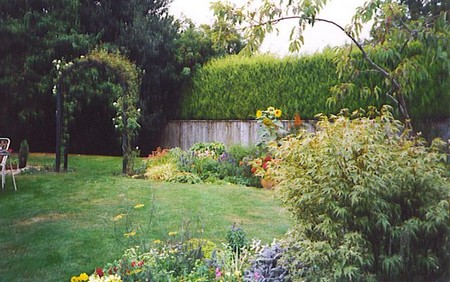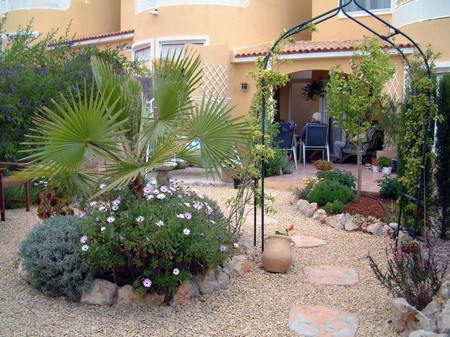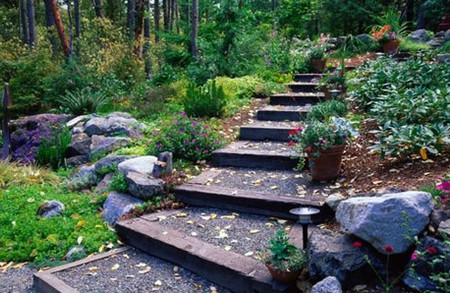Gravel makes an ideal garden surface because it drains well and stands up to a lot of wear. It is cheap, easy to lay and easy to replace, and it is extremely versatile. Gravel is a good choice for a garden that you might want to alter later on, and it is available in many sizes and colours, which can make it the ideal contrast to other materials, such as bricks and paving.
Gravel also forms an excellent light-coloured background against which plants can be displayed. It has a softer look than most surfacing materials, and the mood of the garden changes with the weather, as gravel looks very different according to whether it is wet or dry. The inclusion of a small lawn prevents the garden from appearing rather stark.
This garden includes lots of changes in colours, textures and heights, and it is a warm, bright, cheerful asset to the house. The underlying shape of the site is square, and the design is deliberately not symmetrical to offset this. The different elements are incorporated into the comparatively small space to create an intriguing and inviting garden, which is all about contrast and harmony between brick, lawn and gravel. The raised patio makes a strong statement, but it is offset perfectly by the lawn and shrubs.
Features
The gravel chosen here is cream in colour and uniform in size to create a feeling of harmony and an even texture. It gives the impression of flowing around the garden, linking all the areas and tying the garden together. The corner bed, which is planted with taller shrubs to provide seclusion, is surrounded with the gravel, which appears to continue around the bed, creating the illusion that the garden goes on beyond. This also gives the impression that the entire garden cannot be seen all at once.
A small paved patio has been built out of contrasting rectangular bricks to create a distinct area. The use of strongly coloured bricks emphasizes the shape of the patio and provides a platform to display plants in containers, which fill this area, adding colour and warmth. The narrow walls of the patio provide the perfect perch for small pots of colourful plants and raise them to eye level. A smaller square has been built in front of the patio with larger white bricks, and this houses a sunken container filled with bright flowering plants.
The lean-to conservatory against the house wall takes up little space and links the house to the garden. An extended range of tender plants can be grown in this as it provides additional warmth and shelter.
A small lawn provides a contrast of texture and colour. Gravel is prevented from migrating on to it by a hard edging of stone, and containers are positioned on the gravel side of the edging to soften it and to link the lawn and gravel areas. The lawn itself is shaded and made more secluded by the shrubs that are planted around it, and their lush growth is a fine contrast with the gravel.
Small containers with visually exciting plants, such as Phormiurn cookianum subsp. hookeri ‘Cream Delight’ and Lilium davidii, are used on the area between the raised brick patio and the house wall to provide planting that is controlled but interesting. If necessary they can be moved to the patio or into the conservatory for overwintering.
The oval bed, which is edged with tough chunks of stone, is richly planted with a variety of plants that come into flower sequentially over a long period to provide an ever-changing focal feature. This is complemented by a small semicircular bed against the wall.
Placing a single paver in the gravel adds a surprise element. It breaks up what could potentially be a rather large, uninteresting stretch of gravel, and it could be used as a platform for a container if you wish.
The water feature is very simple – a sink with gently flowing spout running into it -but it adds the gentle sound of water and creates a focal point in the part of the garden near the garage wall.
Planting
The planting in this garden is restricted to relatively small concentrations, rather than being in borders around the edges, but it is effective and does not rely on flowers alone for colour. Foliage interest is provided by the rich, deep reds of the plants on the patio, including Ajuga reptans ‘Catlin’s Gianf, and the textures and shades of green of the lawn and shrub bed.
One or two climbers are used to clothe the top of the far wall and a trellis guides a climber up the house wall near the lawn, but for the most part the walls are left bare to accentuate the planting and to keep the eye within the garden.
The tall Trachycarpus fortunei (Chusan palm), with its interesting spiky foliage, is planted in the far corner to create a visually compelling feature to draw the eye. Flowers in the main shrub bed are largely white to provide contrast with the greenery.
Categories
Advertisements
Recent Articles
 How to Understand Bed Sizes – A Small Guide
How to Understand Bed Sizes – A Small Guide How to Select Some Must Have Kitchen Accessories
How to Select Some Must Have Kitchen Accessories Best Way to Change a Car Tire
Best Way to Change a Car Tire Best Way to Write an Affirmation
Best Way to Write an Affirmation Best Way to Take Charge of Your Financial Life
Best Way to Take Charge of Your Financial Life Best Way to Survive a Party When You Don’t Know Anyone
Best Way to Survive a Party When You Don’t Know Anyone Best Way to Stop Self Sabotaging Yourself
Best Way to Stop Self Sabotaging Yourself Best Way to Start Journal Writing
Best Way to Start Journal Writing Best Way to Speak with a Powerful Voice
Best Way to Speak with a Powerful Voice Best Way to Simplify Your Life
Best Way to Simplify Your Life Best Way to Respond to a Put-Down
Best Way to Respond to a Put-Down Best Way to Reduce Acne Breakouts
Best Way to Reduce Acne Breakouts Best Way to Recover from Dining Disasters
Best Way to Recover from Dining Disasters Best Way to Quit Your Job Gracefully
Best Way to Quit Your Job Gracefully Best Way to Make Your Own Website
Best Way to Make Your Own Website




Leave a Reply